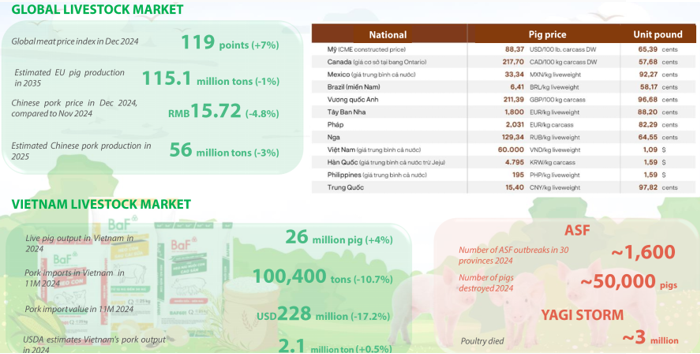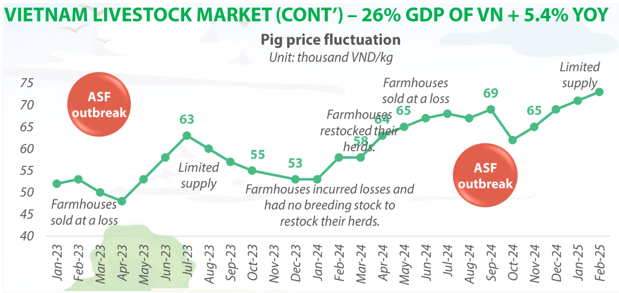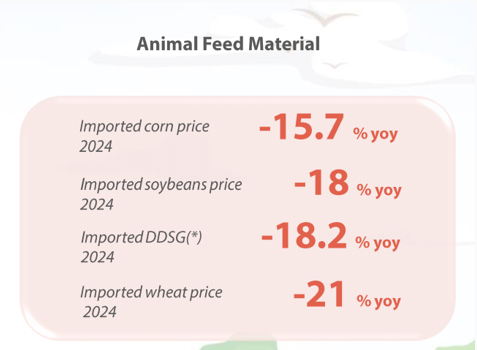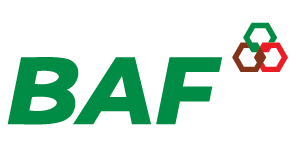BAF Vietnam Agriculture Joint Stock Company (HOSE: BAF) announced that after aggressively acquiring 13 livestock companies within two months since late 2024, the company is still in negotiations to acquire an additional 10-12 new farms. This information was disclosed during an investor meeting on the morning of February 10, 2025.
Pork prices continue to increase amid declining supply
According to BAF’s latest update, the global pork price index reached 119 points in December 2024, marking a 7% year-over-year increase. Disease outbreaks in Europe, South Korea, and Southeast Asia are slowing production growth, while U.S. slaughter restrictions and EU regulations are further driving up pork prices. These conditions have contributed to growth and profitability improvements for livestock companies.
The latest quarterly report forecasts a 1% decline in global pork production, reaching approximately 115.1 million tons due to lower output in China. In Europe, pork production is expected to decrease by 0.5% annually. Overall, pork is anticipated to trade at high price levels throughout the year.
Similarly, in China, pork prices rose by 15% in 2024 due to low supply and rising demand. While livestock profitability improved, pork production is projected to decline by around 2% in 2025, reaching 26 million tons, which is expected to support further price increases.

In Vietnam, the livestock industry ended 2024 facing major challenges from disease outbreaks and Typhoon Yagi. Despite this, the sector remains optimistic, contributing over 26% to GDP. Livestock production value is estimated to have grown by approximately 5.4% year-over-year, driven by rising live hog prices and a decrease in small-scale farming.
Total herd size increased slightly by 4%, yet still fell short of domestic demand. According to the General Department of Customs, Vietnam imported over 100,000 tons of fresh, chilled, or frozen pork in the first 11 months of 2024, valued at $228 million (down 17.2%). The country currently imports pork from more than 40 markets, primarily Brazil, Russia, and Canada.
ASF Outbreaks and Regulatory Challenges Impacting Supply
Regarding the African Swine Fever (ASF) situation, industry representatives reported the emergence of a new chronic strain that is reducing the number of healthy pigs. Global ASF developments are expected to remain complex in the near future.
In Vietnam, ASF continues to spread with multiple new variants. Nearly 1,600 new outbreaks were recorded nationwide – up 79% year-over-year in 48 provinces and 2.5 times higher in 20 provinces. This is expected to put further pressure on pork supply.
During Q4, ASF, coupled with the aftermath of Typhoon Yagi and the new Livestock Law effective from January 1, 2025, severely impacted pork supply. Many farmers rushed to sell pigs before shutting down operations, temporarily increasing supply and driving year-end prices down. Pork prices remained stagnant during the Tet holiday due to additional disease outbreaks, including foot-and-mouth disease.
However, pork prices have been rising after New Lunar Year, reaching nearly VND 73,000/kg due to supply shortages. In southern Vietnam, where illegal imports from Cambodia influence the market, prices have surpassed those in the north. This trend suggests a structural supply shortage rather than a temporary fluctuation. As a result, pork prices are expected to continue rising.

In the animal feed market, prices of most raw materials have declined compared to the previous year- imported corn is down 16%, soybeans down 18%, and wheat down 21%. This trend is primarily due to a reduction in total livestock numbers, which benefits large-scale producers.

Doubling Profits in 2025 and Aggressive M&A Strategy
Following a strategic partnership with Muyuan Group in November 2024, BAF successfully acquired 13 companies within just over two months. These acquisitions include land and farm facilities, with legal procedures currently underway before full-scale construction begins.
The expansion aligns with BAF’s ambition to reach 10 million commercial pigs by 2030. According to Mr. Ngo Cao Cuong, Deputy CEO of BAF, the company is negotiating to acquire an additional 10-12 companies in preparation for 2026. Meanwhile, newly built farms are expected to be stocked with pigs in 2025.
“If opportunities and resources align, we may even reach the 10 million pigs before 2030. We cannot outline a fixed M&A plan – whenever suitable land and farms are available, we will proceed with acquisitions. Currently, BAF is negotiating to purchase 10-12 more farms for the upcoming growth phase,” said Mr. Cuong.
Regarding financial targets, Mr. Cuong stated that detailed plans would be disclosed at the 2025 Annual General Meeting. However, initial projections suggest that BAF plans to sell 900,000 to 1 million commercial pigs, generating approximately VND 6 trillion in revenue (based on a price range of VND 55,000-60,000/kg). The profit target is set at 2.5 times the realized profit in 2024. Additionally, BAF will continue narrowing its focus, exiting the agricultural commodity trading segment due to its low-profit margins.
“Nếu giá duy trì như hiện tại, lợi nhuận thực hiện được có thể nhiều hơn nữa” – theo ông Cường.
“If current price levels hold, actual profits could be even higher,” Mr. Cuong added.
Long-Term Vision: Transforming into a Food Company by 2030
Beyond 2030, BAF aims to reposition itself as a food company, offering higher-margin products. To support this shift, the company plans to commence construction of a processing plant in Binh Phuoc soon.
“BAF is currently positioning itself as a livestock company until 2030, or possibly earlier. After 2030, we will transform into a food company, supplying ready-to-eat and ready-to-cook products. For now, we are developing the 3F model (Feed-Farm-Food) to meet immediate market demand. By April-May 2025, we will break ground on a processing, slaughtering, and central kitchen plant in Binh Phuoc. The land acquisition and investment approval process have been completed, with over VND 100 billion invested several years ago.”



